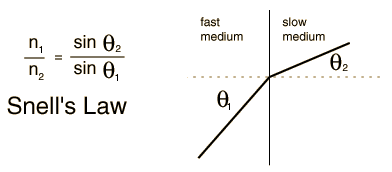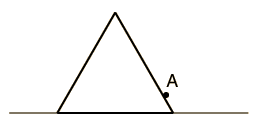Reflection and Refraction
When the phrase "ray of light" is used, it often means the same as "line of sight". In this lab, the "laws" of reflection and refraction are to be studied by using the equivalence of these two ideas.
A. Reflection of Light from a Mirror
Tape a plain sheet of paper to the piece of cardboard supplied. Draw a line across the center of the paper and place the mirror along this line. Support the mirror by fastening it to a wooden block. Try to keep the mirror line from moving during the experiment.
Place a pin A about 3 inches in front and toward one side of the mirror. Place a second pin B about an inch from the mirror near the center of the page. Sighting along the table top, place a third pin C so that it lines up with both the second pin and the mirror image of the first pin (see diagram). These pins define the line of sight or light ray in this case.

Remove the pins and mirror, draw in the rays, measure and record the angles. What is your conclusion? Repeat the above procedure using a different position for the pins to get a new set of data.
B. Refraction
Start with a new, plain sheet of paper taped to the cardboard and make a set of perpendicular lines that cross near the center of the page. Place one pin O at the crossing point of the lines and place the glass cube or plate against this line with one side placed along the line .
Carefully trace the glass block or plate on your paper. Now place a second pin A above and to the left of the first and a third pin B against the glass and in line with the first two as seen looking through the glass. Finally, place a fourth pin C on the viewing side of the glass, in line with pin B and the images of the other pins seen through the glass.
Remove the glass and pins and draw the path taken by the ray of light. Measure the angles of the incoming ray and the ray in the glass. It is standard practice to measure ray angles with respect to the normal (the perpendicular line to the entrance surface). With a protractor, measure the angles of the incoming ray and the ray you have drawn through the glass.
The index of refraction of a material is defined by n = c/v where c is the velocity of light in vacuum (3 x 108 m/sec) and v is the velocity in the medium. When light is refracted at a surface, the angles of the incident and refracted rays are related by Snell's law:
Since the index of refraction of air is almost one (nair = 1.00028), the index of refraction of the glass can be determined by

Using a calculator or computer to determine the sines of the angles you have measured, compute the index of refraction of the glass and the speed of light in that glass.

You will be provided with a prism which has two edges clear and one edge frosted (the base of the prism). Draw a line across a sheet of paper, place the base of the prism along this line, and carefully trace it on the paper. Place a pin A in the position shown in the figure. Sighting past A and through the prism, place another pin B about three inches from the opposite side of the prism where you can see it and line it up with A. Place a third pin C closer to the prism on the same side as B so that all three pins line up when viewed through the glass. Finally place a fourth pin on the viewing side to define the ray coming to your eye from the prism. Remove the pins and prism and draw the paths of the light rays.

Equipment: Reflection and Refraction
- Mirror
- Flat glass plate
- Glass prism
- Straight pins
- Carboard sheet